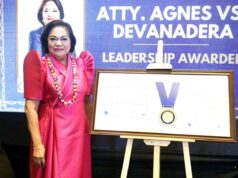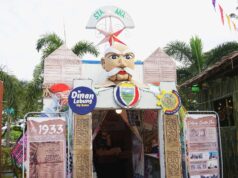ANGELES CITY – A strengthening of the parts to strengthen the whole. Fortify the provinces to fortify the nation.
In every sense, this is the direction being undertaken by Bulacan and Pampanga—the same provinces that the Spanish colonial government sought to divide to frustrate an uprising. The two provinces nevertheless merged forces to move forward the 1898 Revolution.
“Spaniards recognized that national unity would begin with the Tagalog-Pampango unity. It was these two tribes—the wicked accomplices—that determined the shape of our history and our geography. The colony was maintained for almost four centuries only because Spain relied on the Tagalog-Pampango alliance. The empire of Spain could not have survived without the consent of these two tribes,” wrote Nick Joaquin in “The Aquinos of Tarlac.”
In circa 2009, the two provinces are unifying further as their contribution to nation-building.
Some 200 historians, cultural activists, artists, educators, tourism advocates and local officials did that by gathering for a three-day First National Conference of Bulacan and Pampanga in Angeles City last week.
“We hope that this conference will inspire other provinces to do the same in order to strengthen our young nation,” said Robby Tantingco, executive director of the Holy Angel University’s Center for Kapampangan Studies, one of conference’s organizers.
The Arte Bulakenyo Foundation Inc. (ABFI), Bulacan State University’s Center for Bulacan Studies, provincial governments of Bulacan and Pampanga and the National Commission on Culture and the Arts put together what should be considered a “very momentous event,” said BSU president Dr. Mariano de Jesus.
“Sangadaan sa Iisang Daan (Crossroads from the Main Road),” as theme, is a reference to the convergences and divergences in the history, arts and culture of the two provinces.
Bulacan Gov. Joselito Mendoza and the provincial board declared every June the “Day of Friendship of the Bulakenyo and Kapampangan.”
The date is based on the anniversary of the Bangkusay Revolt that started on June 3, 1571 when the people of Hagonoy, Bulacan and Macabebe, Pampanga merged their might to repel the Spaniards.
Mendoza referred to Pampanga as the “Ina (mother)” of Bulacan, referring to the time when the latter was part of the original territory of the former until 1755.
Bulacan is believed to be at the edge of the Tagalog region that extended up to Cavite. Pampanga and Bulacan, separated by the Pampanga River, did not share a common language but shared local history in times of war and peace, their leaders becoming among the founders of the Malolos Congress that framed the Constitution of the First Republic.
Pampanga Gov. Eddie Panlilio noted that various towns of Bulacan still bear Kapampangan names for places and likened the unifying and diverse elements of the two provinces to “Manny Pacquiao, sisig and longganiza.”
“What is important is we find the saysay (significance) and kahulugan (meaning) in this rarefied air of academic discussions,” Panlilio said.
“Pagpapatibay ng pagbubuklod (strengthening of unity)” was how Jose Clemente, president of ABFI called the conference.
Among the 30 or so papers presented in the conference are “Bulacan as a former part of Pampanga,” “Bangkusay: A Study of the 16th Century Filipino Warfare at the Arrival of the Spaniards,” “Gentlemen in the Pangpang: The Testament of Don Fernando Malang Balagtas and the first community in the Philippines,” “Kapampangan Culinary Arts,” “Kaluto: The Legacy of Tita Mila Enriquez in the art of Bulacan cuisine” and “Feasts and Fiestas: An Examination of Bulacan Fiestas.”
Tantingco said the conference followed that of the Pampanga-Cavite conference in 2005.
In every sense, this is the direction being undertaken by Bulacan and Pampanga—the same provinces that the Spanish colonial government sought to divide to frustrate an uprising. The two provinces nevertheless merged forces to move forward the 1898 Revolution.
“Spaniards recognized that national unity would begin with the Tagalog-Pampango unity. It was these two tribes—the wicked accomplices—that determined the shape of our history and our geography. The colony was maintained for almost four centuries only because Spain relied on the Tagalog-Pampango alliance. The empire of Spain could not have survived without the consent of these two tribes,” wrote Nick Joaquin in “The Aquinos of Tarlac.”
In circa 2009, the two provinces are unifying further as their contribution to nation-building.
Some 200 historians, cultural activists, artists, educators, tourism advocates and local officials did that by gathering for a three-day First National Conference of Bulacan and Pampanga in Angeles City last week.
“We hope that this conference will inspire other provinces to do the same in order to strengthen our young nation,” said Robby Tantingco, executive director of the Holy Angel University’s Center for Kapampangan Studies, one of conference’s organizers.
The Arte Bulakenyo Foundation Inc. (ABFI), Bulacan State University’s Center for Bulacan Studies, provincial governments of Bulacan and Pampanga and the National Commission on Culture and the Arts put together what should be considered a “very momentous event,” said BSU president Dr. Mariano de Jesus.
“Sangadaan sa Iisang Daan (Crossroads from the Main Road),” as theme, is a reference to the convergences and divergences in the history, arts and culture of the two provinces.
Bulacan Gov. Joselito Mendoza and the provincial board declared every June the “Day of Friendship of the Bulakenyo and Kapampangan.”
The date is based on the anniversary of the Bangkusay Revolt that started on June 3, 1571 when the people of Hagonoy, Bulacan and Macabebe, Pampanga merged their might to repel the Spaniards.
Mendoza referred to Pampanga as the “Ina (mother)” of Bulacan, referring to the time when the latter was part of the original territory of the former until 1755.
Bulacan is believed to be at the edge of the Tagalog region that extended up to Cavite. Pampanga and Bulacan, separated by the Pampanga River, did not share a common language but shared local history in times of war and peace, their leaders becoming among the founders of the Malolos Congress that framed the Constitution of the First Republic.
Pampanga Gov. Eddie Panlilio noted that various towns of Bulacan still bear Kapampangan names for places and likened the unifying and diverse elements of the two provinces to “Manny Pacquiao, sisig and longganiza.”
“What is important is we find the saysay (significance) and kahulugan (meaning) in this rarefied air of academic discussions,” Panlilio said.
“Pagpapatibay ng pagbubuklod (strengthening of unity)” was how Jose Clemente, president of ABFI called the conference.
Among the 30 or so papers presented in the conference are “Bulacan as a former part of Pampanga,” “Bangkusay: A Study of the 16th Century Filipino Warfare at the Arrival of the Spaniards,” “Gentlemen in the Pangpang: The Testament of Don Fernando Malang Balagtas and the first community in the Philippines,” “Kapampangan Culinary Arts,” “Kaluto: The Legacy of Tita Mila Enriquez in the art of Bulacan cuisine” and “Feasts and Fiestas: An Examination of Bulacan Fiestas.”
Tantingco said the conference followed that of the Pampanga-Cavite conference in 2005.




